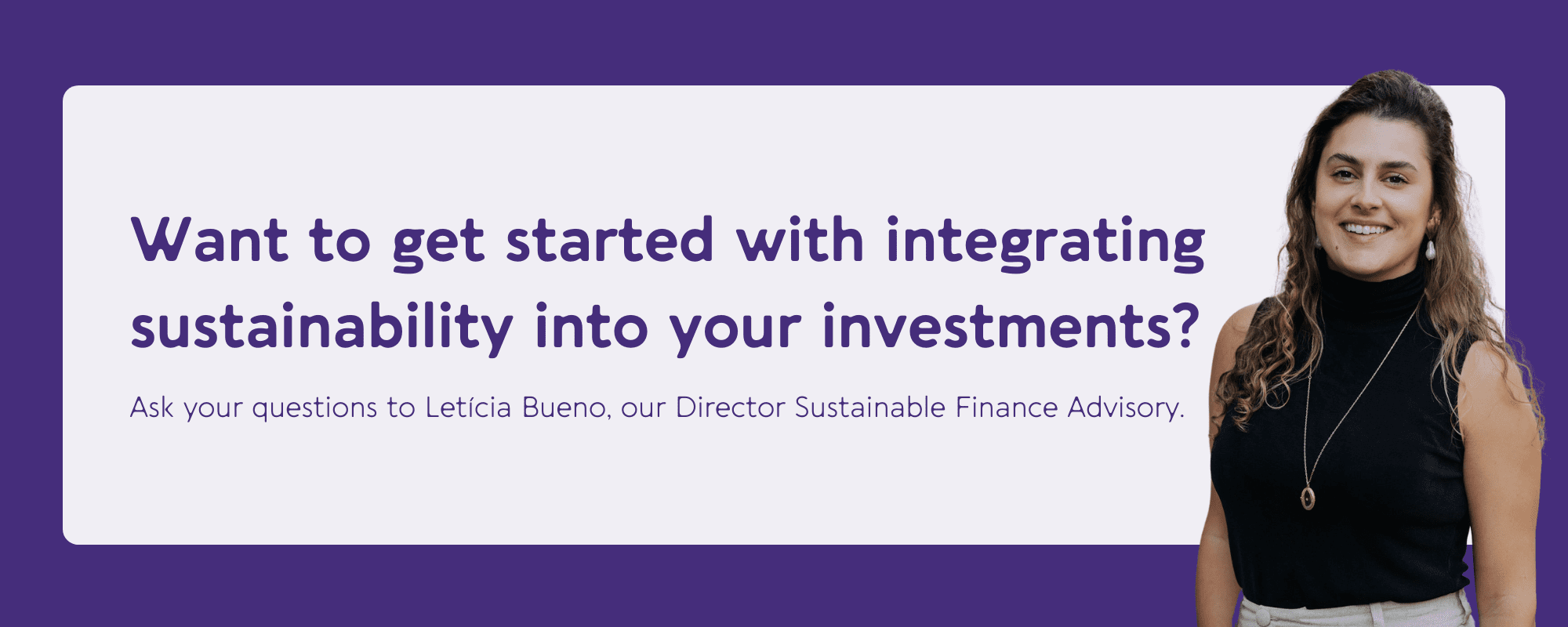Integrating Sustainability into Investments: Navigating Sustainable Investing
In the evolving landscape of finance, sustainable investing is no longer a niche concept; it has become a pivotal element in shaping the future of global economies. It is increasingly hard for Fund Managers to market funds with no sustainability ambition, with many opting to pivot towards ESG. Therefore, as Funds become eager to start their journey with sustainable investments, preparation is a key aspect to consider.
Sustainable investing involves a comprehensive approach that spans three main phases: pre-investment, investment, and portfolio management. Each phase contains important steps in ensuring that the investment not only meets financial objectives but also contributes positively to environmental and social goals. In this blog, we will go over the step-by-step process of sustainable investing for Fund Managers.
What is Sustainable Investing?
Sustainable investing refers to the practice of investing in assets that contribute to environmental and social objectives, while also ensuring that these investments do no significant harm to other such objectives and adhere to good governance practices. At Sustainable Capital Group (SCG), we define sustainable finance transactions in line with the Sustainable Finance Disclosure Regulation (SFDR) as investments in economic activities that contribute to environmental or social objectives, such as promoting circular economy practices in projects and reducing inequality. This concept is increasingly gaining traction as both investors and consumers demand more responsible and ethical financial practices as well as transparency.
The SFDR plays a significant role in defining the framework for sustainable investments. It distinguishes between three disclosure levels for investments — Article 6, Article 8, and Article 9 — each representing a different degree of sustainability integration and transparency. Find out more about SFDR and its classifications on our blog.
Under SFDR, to be classified as a sustainable investment, an investment must meet three criteria:
- Contribute to an environmental or social objective: This could include investments in renewable energy, clean technologies, or initiatives aimed at improving social welfare.
- Do-no-significant-harm to other objectives: The investment should not negatively impact other environmental or social goals.
- Uphold good governance practices: This involves ensuring that the investee companies follow sound management practices, including transparent decision-making and adherence to ethical standards.
Considering the impact of your investments
An essential part of integrating sustainability into your investments is to consider its impacts on the outside world or ‘inside – out’. Historically, sustainability risks were viewed from an “outside-in” perspective — focusing on how ESG factors could impact the financial value of an investment. However, this approach is no longer sufficient under SFDR.
Today, we must also consider how the investment itself impacts the environment and society — both in terms of positive and adverse impacts. This is an integral step funds must take to qualify as an Article 8 or Article 9 investment Fund. The disclosures of your investment’s impact also highlight a key difference between SFDR’s Article 8 and Article 9: while Article 8 allows for adverse impacts to be overlooked in disclosures, Article 9 requires a full disclosure of both positive and adverse impacts.
As a fund, assessing your investments’ impact is a key step for sustainable investing. Beyond the need for driving positive impact on the environment or society, considering your investment’s potential adverse impact can be a safer strategy in the long-run; this way, you’re prepared when the adverse impacts of today become the sustainability risks of tomorrow.
Step-by-Step Guide to Sustainable Investing As a Fund
Pre-Investment Phase
Defining SFDR Disclosure Level: Article 6, 8 or 9
The pre-investment phase in sustainable investing is critical for laying the groundwork for successful and impactful investments. This phase begins with defining the SFDR disclosure level, which involves setting clear sustainability ambitions for the fund.
The Sustainable Finance Disclosure Regulation (SFDR) provides a structured framework for determining the sustainability focus of investments, with Article 6, 8, and 9 each representing different degrees of sustainability integration. Establishing this foundation early is crucial, as it shapes the fund’s overall approach to sustainable investing and ensures transparency with potential investors through detailed pre-contractual disclosures and marketing materials. The chosen disclosure level should align closely with the Fund’s investment strategy.
Materiality Assessment
Conducting a thorough materiality and regulatory analysis is another crucial component of the pre-investment phase. This analysis is necessary for the Fund identify external risks and impacts that could affect its sustainability objectives. It’s important to differentiate between sustainability impacts (positive or negative effects of the fund’s activities), adverse impacts (specific negative consequences), and positive impacts (beneficial outcomes of the fund’s investments). Understanding these distinctions is key to complying with the SFDR’s definition of sustainable investment and for making informed decisions that align with the fund’s sustainability commitments.
Creating a Sustainability Integration Policy
Finally, the pre-investment phase includes developing a sustainability integration policy. This policy operationalizes the fund’s sustainability goals by establishing procedures for incorporating sustainability into its day-to-day operations, including data management practices. By setting clear guidelines for monitoring and reporting on sustainability performance, the fund can ensure that its investments consistently align with its sustainability objectives, creating a solid foundation for successful sustainable investing.
Investment Phase
Preparing the ESG Data Sheet
The investment phase is where the sustainable investment strategy begins to take tangible form, transforming plans and policies into actionable investments. A critical first step in this phase is the preparation of an ESG (Environmental, Social, and Governance) data sheet. This document compiles essential sustainability data and KPIs that will be used to evaluate potential investment targets. Preparing the ESG data sheet before making investments ensures that the fund has a comprehensive understanding of each target’s sustainability credentials, which is vital for making informed investment decisions.
Due Diligence Assessment
With the ESG data sheet in hand, the next step is conducting ESG due diligence. This process involves a thorough assessment of potential investment targets to determine how well they meet the fund’s sustainability criteria. ESG due diligence goes beyond traditional financial analysis by incorporating environmental, social, and governance factors into the evaluation process. The outcomes of this analysis can significantly influence the investment decision, serving as a binding factor in the investment decision-making process. It ensures that the fund’s investments align with its sustainability goals and adhere to the principles outlined in the SFDR.
(Sustainable) Investment Decision
The final stage of the investment phase is the investment decision itself. After a detailed ESG due diligence process, the fund must analyse the sustainability credentials of the investment target to make a final decision. This decision is not just about financial returns; it also considers the potential impact of the investment on the environment and society. The integration of sustainability into the investment decision process helps ensure that the fund’s portfolio is not only financially sound but also aligned with its broader environmental and social objectives. By thoroughly evaluating each potential investment through a sustainability lens, the fund can build a portfolio that truly reflects its commitment to sustainable investing.
Portfolio Management Phase
Defining Portfolio Company ESG Action Plan
Once investments are made, the portfolio management phase focuses on ensuring that the fund’s sustainability goals are maintained and enhanced throughout the holding period. A key component of this phase is the creation of an ESG action plan. This plan, developed in collaboration with portfolio companies, sets specific targets and KPIs tailored to each company’s operations. The ESG action plan serves as a roadmap for continuous improvement, guiding companies in their efforts to enhance their sustainability practices during the investment period.
Reporting and Disclosing Transparently
Regular and transparent reporting is another critical aspect of the portfolio management phase. Under the SFDR, funds are required to provide annual updates on their periodic disclosures, which detail the progress of the fund’s sustainability efforts. These reports not only demonstrate compliance with regulatory requirements but also offer insights into how the fund’s investments are contributing to its overall sustainability objectives. Ensuring that these reports are thorough and up-to-date is essential for maintaining investor confidence and demonstrating the fund’s ongoing commitment to sustainable investing.
In addition to regular reporting, funds that have declared principal adverse impacts (PAIs) are required to prepare a Principal Adverse Impacts Statement. This document provides an annual assessment of any negative impacts that the fund’s investments may have on sustainability factors. While reporting on PAIs is only necessary if the fund has declared them, it is a crucial step in maintaining transparency and accountability in sustainable investing.
Assessing the Investment’s Sustainability Performance
Finally, as investments mature and the fund reaches the exit or fund close stage, it’s important to assess and report on the sustainability performance of the fund and its investments. If applicable, this stage may also involve the distribution of Impact Linked Compensation, which rewards the fund based on its success in achieving its sustainability targets. Through careful management and reporting, the portfolio management phase ensures that the fund’s investments continue to contribute to its sustainability goals, providing long-term value for both investors and society.
Conclusion
Sustainable investing is the necessary evolution in the financial world that addresses the pressing environmental and social challenges of our time. By following a structured approach—spanning from pre-investment planning to ongoing portfolio management—investors can ensure that their investments contribute to a more sustainable future while also delivering financial returns. As sustainable investing continues to gain momentum, it presents a unique opportunity for funds and investors alike to drive positive change and achieve long-term success for investors and investees alike.
Whether you’re a seasoned investor or just starting out, understanding the intricacies of sustainable investment is key to making informed decisions that align with your values and financial goals. At Sustainable Capital Group, we are committed to guiding you through this process, helping you navigate the complexities of sustainable finance, and ensuring that your investments make a meaningful impact.
Any questions?
At Sustainable Capital Group, we understand the complexities of EU regulations in sustainable finance, and our sector experts are here to assist you. For personalised guidance, simply fill out our contact form, and we’ll be in touch with you shortly.



